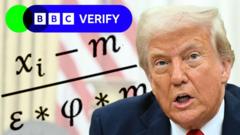President Trump's recent tariffs on imported lithium-ion batteries, primarily from China, may severely impact the growth of energy storage systems in the United States. This move threatens the deployment of critical technologies that facilitate renewable energy use, ultimately affecting grid reliability.
Tariffs on Batteries Threaten US Energy Storage Expansion

Tariffs on Batteries Threaten US Energy Storage Expansion
New tariffs imposed by the Trump administration could hinder advancements in energy storage technologies vital for renewable energy.
The Trump administration's newly announced tariffs on imported lithium-ion batteries have sparked concerns among energy experts and companies alike, threatening the substantial progress made in the energy storage sector across the United States. These tariffs could curtail the increasing reliance on giant batteries that allow energy companies to optimize their use of wind and solar power.
In recent years, energy storage has blossomed into a key component of the U.S. energy landscape, with companies in states such as Texas and Arizona turning to large lithium-ion battery arrays to effectively harness excess renewable energy and deploy it when demand peaks. The potential for batteries to mitigate reliance on fossil fuels was exemplified in California, where battery storage has enabled utilities to utilize solar power even during evening hours.
However, a significant portion of American lithium-ion batteries—about 69%—are imported from China. Following President Trump's tariff announcement, these imports will incur a staggering tax rate rise to 64.5% starting immediately, with projections suggesting an increase to 82% in the following year. Jason Burwen, vice president of policy and strategy at GridStor, expressed that such tariffs would dramatically impede U.S. energy storage deployment, with detrimental effects for both business operations and grid reliability.
Despite lawmakers' previous optimism predicting a record installation of 18,200 megawatts of battery capacity this year alone—equivalent to the output of 18 large nuclear reactors—the newly imposed tariffs could pose a significant obstacle. The U.S. Energy Information Administration indicates that energy storage capacity had already surged by 66% in 2024 compared to previous years.
The future of energy storage in the United States may now stand at a daunting crossroads, with implications reaching far beyond mere economics, potentially influencing national energy strategies as the country works to achieve greater renewable integration and environmental goals.





















